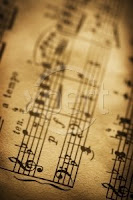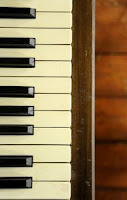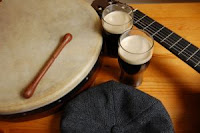
Sometimes we assume that everyone is familiar with the same things we're familiar with -- and sometimes we're wrong in doing so!
Guitar Tablature is one of those things -- guitar players are usually quite familiar with it -- but other musicians may have never heard of it. Most stringed instruments have some tablature notation -- for instance, banjo tab or ukulele tab -- even lute tab!
In any case, I'd like to post this short article (written by Howard Wright at Howard.Wright@ed.ac.uk) on reading and writing Guitar Tablature!
CONTENTS - Part I
------------------
1.0 What is TAB
1.1 What TAB will tell you
1.2 What TAB won't tell you.
Reading Tab :
--------------
2.0 TAB notation - The Basics
2.1 Other symbols used in TAB
2.2 Hammer ons and pull offs
2.3 Bends
2.4 Slides
*** 1.0 WHAT IS TAB ***
TAB or tablature is a method of writing down music
played on guitar or bass. Instead of using symbols like
in standard musical notation, it uses ordinary ASCII
characters and numbers, making it ideal for places
like the internet where anybody with any computer can
link up, copy a TAB file, and read it.
*** 1.1 WHAT TAB WILL TELL YOU ***
TAB will tell you what notes to play - it will tell you
which string to hit and which fret to fret it at.
TAB will tell you where hammer-ons, pull-offs, bends, slides, harmonics and
vibrato are used.
TAB will tell you what tuning the piece is in. If this isn't given explicitly, assume normal tuning. TAB should also give you information on use of capos etc.
TAB will give you an indication of the ryhthm of the piece - i.e it will tell you which are the long notes and which are the short notes.
However it will not tell you exactly how long or how short they are.
This leads me on to ...
*** 1.2 WHAT TAB WILL NOT TELL YOU ***
TAB will (usually) not tell you the note lengths of the notes - so in most cases you will *have* to listen to the song yourself, with the TAB in front of you to work out the ryhthm of the notes.
TAB will not tell you which fingers you use to fret which note.
TAB will (usually) not tell you anything about picking and strumming - you will have to decide for yourself where to use upstrokes/downstrokes and so on.
*** 2.0 TAB NOTATION - THE BASICS ***
TAB is simple to read, and should be simple to write if you want to submit a song you have worked out yourself. The idea is this :
You start out with 6 lines (or four for bass). These correspond to the strings of the instrument. The top line is the highest pitch string, and the bottom line is the lowest pitch string. Below is a blank bit of TAB with the string names at the left.
E----------------------------------------------------------------
B----------------------------------------------------------------
G----------------------------------------------------------------
D----------------------------------------------------------------
A----------------------------------------------------------------
E----------------------------------------------------------------
Numbers are written on the lines to show you where to fret the string with the left hand. If a zero appears , this means play the open string. Like standard musical notation, you read from left to right to find out what order to play the notes. The following piece of TAB would mean play the sequence of notes (E F F# G G# A) on the bottom E string by moving up a fret at a time, starting with the open string.
E----------------------------------------------------------------
B----------------------------------------------------------------
G----------------------------------------------------------------
D----------------------------------------------------------------
A----------------------------------------------------------------
E---0--1--2--3--4--5---------------------------------------------
OK so far ?
Here we have notes being played one at a time. If two or more notes are to be played together, they are written on top of one another, again just like standard notation.
In the next example we have a G bar chord.
E----3------------------------------------------------------------
B----3------------------------------------------------------------
G----4------------------------------------------------------------
D----5------------------------------------------------------------
A----5------------------------------------------------------------
E----3------------------------------------------------------------
So this means play all these notes together as a chord.
You might see the same chord written like this :
E--------3--------------------------------------------------------
B-------3---------------------------------------------------------
G------4----------------------------------------------------------
D-----5-----------------------------------------------------------
A----5------------------------------------------------------------
E---3-------------------------------------------------------------
Which would mean strum the same shape starting at the bottom string, so that each string is hit slightly later than the last string, but all notes will ring together. Below is am example of the same shape again, but now the gaps between the notes are bigger - so you would probably pick the strings separately instead of slowly strumming the shape.
E------------------3----------------------------------------------
B---------------3-----3--------------------------------------------
G------------4-----------4-----------------------------------------
D---------5-----------------5--------------------------------------
A------5-----------------------5----------------------------------
E---3-----------------------------3--------------------------------
You might ask - How do I know how fast or slow to play this ?
Are all the notes supposed to be the same length ?
This is where TAB differs from standard notation. Most often TAB will *not* give you any information on the note lengths. It is usually left up to you to listen to the song to pick up the rhythm.
However - don't despair. TAB should give you some indications of timing. In the example above all the notes are evenly spaced so you can reasonably assume that the notes are the same length (maybe all eighth notes or quavers) but this may not always be true - it depends on who wrote the TAB.
As a general rule, the spacing of the notes on the TAB should tell you which notes are the long ones, and which are the short and fast ones, but obviously it won't tell you if a note is a triplet or anything like that. Again, this will depend strongly on the person who wrote the TAB.
As an example, here are the first few notes of the American National Anthem in TAB. You should see fairly clearly that the different spacing corresponds to the different note lengths.
E-----------------------0--------4--2-0--------------------------
B---0--------------0---------------------------------0-----------
G------1------1----------------------------1----3----------------
D--------2-------------------------------------------------------
A----------------------------------------------------------------
E----------------------------------------------------------------
Obviously it will be a lot easier to play the TAB for a song you know well than for a song you've never heard of because you will already be familiar with the ryhthms of the familiar song.
*** 2.1 OTHER SYMBOLS USED IN TAB ***
So far I've looked at what notes to play : which string to hit, and where to fret it. I've mentioned how to get an idea of note lengths by looking at the spaces between notes on the TAB, but this can only be a rough guide. You will always have to check with the original track to work out details of the rhythm.
A lot of other imprtant information can be included in a piece of TAB. This includes hammer-ons, pull offs, slides, bends, vibrato and so on.
The standard practice is to write extra letters or symbols between notes to indicate how to play them. Here are the letters/symbols most often used :
h - hammer on
p - pull off
b - bend string up
r - release bend
/ - slide up
\ - slide down
v - vibrato (sometimes written as ~)
t - right hand tap
x - pl!y 'note' with heavy damping
For slides, s is sometimes used to indicate either an up or down slide. Symbols for harmonics are explained below in Section 3.2
That last one, the x, is used to get a choppy, percussive sound. You usually use your fretting hand to lightly damp the strings so that when you pick the note it sounds dead.
Note that the use of 'x' is *totally* different from the use of an 'x' when giving chord shapes.
For example if you wrote the chord of D, you would see :
EADGBE
xx0232
where the 'x's mean do not play this string.
In tab it is implicitly assumed that a string is not played if it is not marked. So the same chord in TAB would be :
E-----2-----------------------------------------------------------
B-----3-----------------------------------------------------------
G-----2-----------------------------------------------------------
D-----0-----------------------------------------------------------
A----------------------------------------------------------------
E----------------------------------------------------------------
with no 'x'. The x is is only used in TAB to represent a heavily muted string which is picked/strummed to give a percussive sound.
There are a number of other symbols for things like whammy bar bends, pick scrapes and so on. There seems to be no particular standard way of writing these - details should be given in the TAB to explain what the symbols mean.
Bass TAB will probably need a few extra symbols to cope with the different techniques used in bass playing - for example slapping and 'popping' the string with thumb or middle finger. You could use 's' for slap and 'p' for pop as long as you wrote them *underneath* the lines of tab to distinguish them from slide
and pull off which would be written *on* the lines of tab.
*** 2.2 HAMMER ONS AND PULL OFFS ***
With hammer-ons and pull-offs you might find things like these :
E----------------------------------------------------------------
B----------------------------------------------------------------
G----------------------------------------------------------------
D----------------------------------------------------------------
A---------5h7-----------5h7--------------------------------------
E---0--0----------0--0-------------------------------------------
which would mean play the open E twice, then hit the A string at the 5th fret and hammer on to the 7th fret.
Pull offs look very similar :
E----3p0------------------------------------------------------------
B---------3p0-------------------------------------------------------
G--------------2p0--------------------------------------------------
D-------------------2---------------------------------------------
A----------------------------------------------------------------
E----------------------------------------------------------------
Here we have a descending blues scale using pull-offs to the open strings. For each pull off you only pick the first note of the pair with the right hand - so in this example you would pick all the notes on the 3rd and 2nd frets, and the open strings would be sounded by pulling off.
Because you give the string an extra bit of energy when you hammer on and pull off, you only need to hit the first note with the picking hand. You could even have a long string of hammer-ons and pull-offs like this :
E----------------------------------------------------------------
B----------------------------------------------------------------
G---2h4p2h4p2h4p2h4p2h4p2----------------------------------------
D----------------------------------------------------------------
A----------------------------------------------------------------
E----------------------------------------------------------------
In this case you only pick the first note.
Note - you might see other symbols used to mean hammer on or pull off, for example ^ can be use to mean hammer-on and pull-off.
e.g :
G---2^4^2----
which would mean "hit the note at the 2nd fret, hammer-on to the 4th and pull-off to the 2nd fret". It would make things easier if everyone used the same symbols, so unless you have a strong objection to 'h' and `p` please use those. In any case, for any tab you send you should always explain what your symbols mean so if you use anything 'unconventional' make sure you explain what it means.
*** 2.3 BENDS ***
When bends are involved you need to know how much to bend the note up. This is indicated by writing a number after the 'b'. For example, if you see this :
E----------------------------------------------------------------
B------7b9-------------------------------------------------------
G----------------------------------------------------------------
D----------------------------------------------------------------
A----------------------------------------------------------------
E----------------------------------------------------------------
it means strike the B string at the 7th fret, then bend the note up two semitones (one whole step) so that it sounds the same pitch as a note fretted at the 9th fret would do. (Sometimes the bend is written with the second part in brackets, like this ---7b(9)--- )
Something like this :
E----------------------------------------------------------------
B------7b9--9r7--------------------------------------------------
G----------------------------------------------------------------
D----------------------------------------------------------------
A----------------------------------------------------------------
E----------------------------------------------------------------
means play the note at the 7th fret, bend up two semitones, strike the note again whilst it is still bent, then release the bend so that the note has it's normal pitch.
Sometimes a pre-bend is used - this is where the string is bent up *before* the note is struck. After striking the note, the bend is released. Pre-bends are usually written like this:
E----------------------------------------------------------------
B------(7)b9r7---------------------------------------------------
G----------------------------------------------------------------
D----------------------------------------------------------------
A----------------------------------------------------------------
E----------------------------------------------------------------
This means: fret the note at the 7th fret and bend the string up two semitones (without actually playing the note). Now strike the string and release the bend.
You sometimes get a note which is bent up only a quarter of a tone or so. In this case it would look a bit strange to write :
B--------7b7.5--------
if you have to bend it up half a fret's worth. Instead it's written as :
bend up 1/4 tone
E----------------------------------------------------------------
B------7b--------------------------------------------------------
G----------------------------------------------------------------
D----------------------------------------------------------------
A----------------------------------------------------------------
E----------------------------------------------------------------
with instructions on how much to bend written above the note.
*** 2.4 SLIDES ***
The most common symbols used for slides are / for a slide up and \ for a slide down.
You might also see 's' used to mean slide.
You don't always need separate symbols for 'up' and 'down' slides since a line of TAB reading :
E----------------------------------------------------------------
B------7/9-------------------------------------------------------
G----------------------------------------------------------------
D----------------------------------------------------------------
A----------------------------------------------------------------
E----------------------------------------------------------------
is clearly a slide *up* from 7th to 9th fret. However you might also see things like these :
E----------------------------------------------------------------
B------/7-9-7\---------------------------------------------------
G----------------------------------------------------------------
D----------------------------------------------------------------
A----------------------------------------------------------------
E----------------------------------------------------------------
where the exact start or finish of a slide is not given. Here you have to know whether you're sliding up or down. In these cases use your judgement to choose the starting or finishing fret. The effect usually desired is to have a note 'swooping in' from a lower pitch or dropping suddenly in pitch as the note fades.
You could have a whole series of slides running together, like this
E----------------------------------------------------------------
B------7/9/11\9\7\6\7--------------------------------------------
G----------------------------------------------------------------
D----------------------------------------------------------------
A----------------------------------------------------------------
E----------------------------------------------------------------
which would mean you only strike the first note with the pick using the sustain to produce the other notes.






